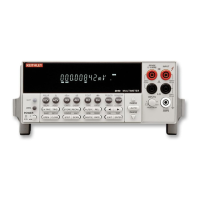Configuration
The following provides the various configuration options for temperature measurements. To
select and configure either a thermocouple or four-wire RTD measurement:
Press SHIFT then SENSOR. Four choices are available using the ▲ and ▼ keys:
• UNITS — C, K, F (Centigrade, Kelvin, Fahrenheit). This parameter selects the displayed
units for temperature measurements.
• SENSOR — TCOUPLE, 4W-RTD (sensor type). This parameter selects the type of
sensor being used.
• TYPE — J, N, T, K (thermocouple type) or PT100, USER, PT3916, PT385, F100, D100
(4W-RTD type). Note that with USER selected, you must set the Alpha, Beta, Delta, and
RZero values from over the GPIB bus or the RS-232 Interface (see “USER RTD Type”
for details).
• JUNC — SIM, CH1 (simulated or referenced at Channel 1). Typically, a thermocouple
card uses a single reference junction. The Model 2010 can simulate a reference junction
temperature or use the reference junction on a thermocouple switching card. Typical
reference junction temperatures are 0°C and 23°C. In order to keep the reference
calculations updated and accurate, Channel 1 needs to be read periodically.
To assign a value to a parameter, use the ▲ and ▼ keys to scroll to the desired parameter.
Select the key, and use the ▲ and ▼ keys to scroll through and choose the preferred value.
Select the ENTER key to save your changes.
USER RTD Type
Alpha, Beta, Delta, and RZero values for the USER RTD type cannot be set from the front
panel. These values can only be set remotely from the GPIB bus or the RS-232 Interface. After
selecting USER, use the following commands to set the RTD factors:
[:SENSe[1]]:TEMPerature:FRTD:ALPHa <NRf> Specify alpha value (0 to 0.01)
[:SENSe[1]]:TEMPerature:FRTD:BETA <NRf> Specify beta value (0 to 1.00)
[:SENSe[1]]:TEMPerature:FRTD:DELTa <NRf> Specify delta value (0 to 5.00)
[:SENSe[1]]:TEMPerature:FRTD:RZERo <NRf> Specify resistance at 0° C (0 to 10000)
NOTE For details on these commands, see “FRTD commands” in the SENSe Subsystem
(Section 5).
Math
Model 2010 math operations are divided into four categories:
• mX+b and percent
• dBm and dB calculations
• Statistics of buffered readings
• Limit testing
2-32 Basic Measurements

